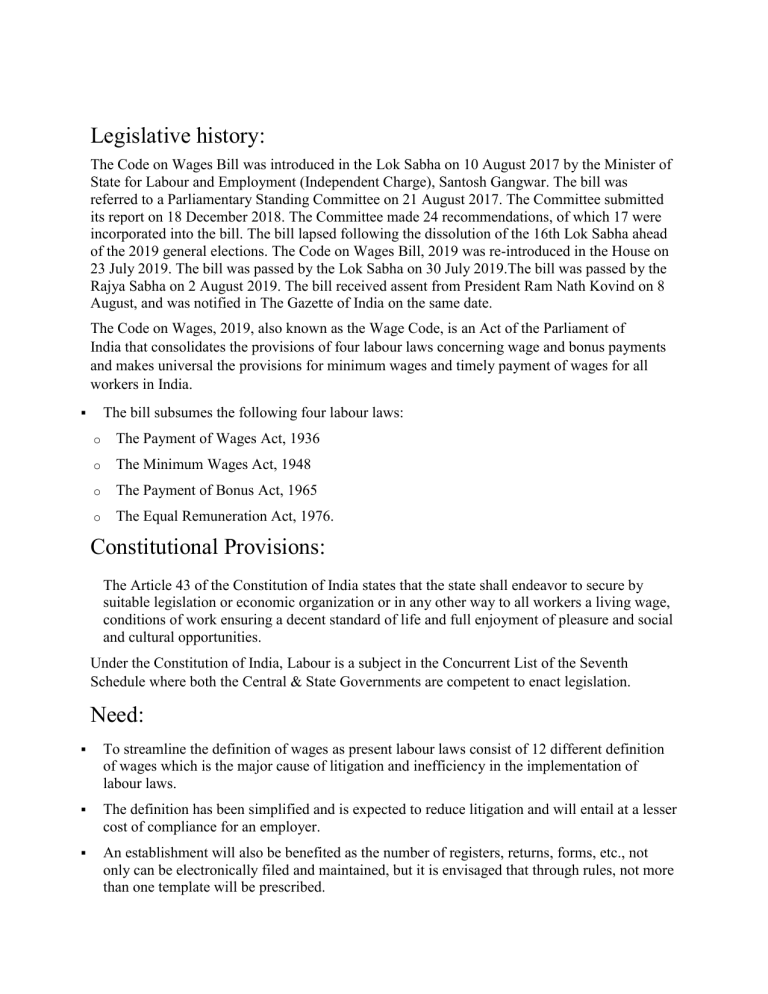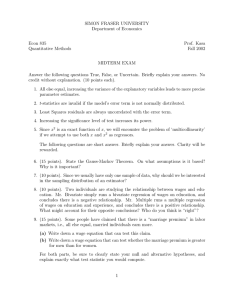
Legislative history: The Code on Wages Bill was introduced in the Lok Sabha on 10 August 2017 by the Minister of State for Labour and Employment (Independent Charge), Santosh Gangwar. The bill was referred to a Parliamentary Standing Committee on 21 August 2017. The Committee submitted its report on 18 December 2018. The Committee made 24 recommendations, of which 17 were incorporated into the bill. The bill lapsed following the dissolution of the 16th Lok Sabha ahead of the 2019 general elections. The Code on Wages Bill, 2019 was re-introduced in the House on 23 July 2019. The bill was passed by the Lok Sabha on 30 July 2019.The bill was passed by the Rajya Sabha on 2 August 2019. The bill received assent from President Ram Nath Kovind on 8 August, and was notified in The Gazette of India on the same date. The Code on Wages, 2019, also known as the Wage Code, is an Act of the Parliament of India that consolidates the provisions of four labour laws concerning wage and bonus payments and makes universal the provisions for minimum wages and timely payment of wages for all workers in India. The bill subsumes the following four labour laws: o The Payment of Wages Act, 1936 o The Minimum Wages Act, 1948 o The Payment of Bonus Act, 1965 o The Equal Remuneration Act, 1976. Constitutional Provisions: The Article 43 of the Constitution of India states that the state shall endeavor to secure by suitable legislation or economic organization or in any other way to all workers a living wage, conditions of work ensuring a decent standard of life and full enjoyment of pleasure and social and cultural opportunities. Under the Constitution of India, Labour is a subject in the Concurrent List of the Seventh Schedule where both the Central & State Governments are competent to enact legislation. Need: To streamline the definition of wages as present labour laws consist of 12 different definition of wages which is the major cause of litigation and inefficiency in the implementation of labour laws. The definition has been simplified and is expected to reduce litigation and will entail at a lesser cost of compliance for an employer. An establishment will also be benefited as the number of registers, returns, forms, etc., not only can be electronically filed and maintained, but it is envisaged that through rules, not more than one template will be prescribed. Highlights of the Bill: The bill aims to transform the old and obsolete labour laws into more accountable and transparent ones and seeks to pave the way for the introduction of minimum wages and labour reforms in the country. It regulates the wages and bonus payments in all employments where any industry, trade, business, or manufacturing is being carried out. It universalizes the provisions of minimum wages and timely payment of wages to all employees irrespective of the sector and wage ceiling and seeks to ensure "Right to Sustenance" for every worker and intends to increase the legislative protection of minimum wage. It has been ensured in the bill that employees getting monthly salary shall get the salary by 7th of next month, those working on a weekly basis shall get the salary on the last day of the week and daily wagers should get it on the same day. The provisions of the bill will apply to all the employees. o At present, the provisions of both the Minimum Wages Act and Payment of Wages Act apply on workers below a particular wage ceiling working in Scheduled Employments only. o Many unorganized sector workers like agricultural workers, painters, persons working in restaurants and dhabas, chowkidars, etc. who were out of the ambit of minimum wages will get legislative protection of minimum wages after the bill becomes an Act. The Central Government is empowered to fix the floor wages by taking into account the living standards of workers. It may set different floor wages for different geographical areas. o The minimum wages decided by the central or state governments must be higher than the floor wage. Wages: According to the bill, wages include salary, allowance, or any other component expressed in monetary terms. This does not include bonus payable to employees or any traveling allowance, among others. Minimum Wage: International Labour Organisation defines it as “the minimum amount of remuneration that an employer is required to pay wage earners for the work performed during a given period, which cannot be reduced by collective agreement or an individual contract”. Or, the minimum wage includes the bare needs of life like food, shelter, and clothing. Living Wage: It is the wage needed to provide the minimum income necessary to pay for basic needs based on the cost of living in a specific community. In addition to bare needs, a ‘living wage’ includes education, health, insurance, etc. Fair Wage: A ‘fair wage’ is a mean between ‘living wage’ and ‘minimum wage’. It simplifies the methodology to fix minimum wage by doing away with the “type of employment” as one criterion. The minimum wage fixation would primarily be based on geography and skills. In order to ensure transparency and accountability, the bill seeks to reform the inspection regime by introducing web based random computerised inspection scheme, jurisdiction-free inspections, calling of information electronically, the composition of fines, etc. To streamline the claims of workers, the limitation period for filing claims for minimum wages, bonus, equal remuneration has been raised to 3 years. It prohibits gender discrimination in matters related to wages and recruitment of employees for the same work or work of similar nature. Impact: It seeks to reduce compliance costs for employers. It is expected to reduce litigation as it streamlines the definition of wages. It will substantially reduce the number of minimum wages in the country from the existing more than 2000 rates of minimum wages. This would ensure that every worker gets a minimum wage which will also be accompanied by an increase in the purchasing power of the worker thereby giving a fillip to growth in the economy. THE CODE ON WAGES ,2019 ON GENDER EQUITY. How women are discriminated at workplace : Consider the recent happening in the Beed district of Maharashtra. Menstrual periods hinder work and attract fines. The answer, in Beed, is to go in for a hysterectomy so the women no longer have them. Cane-cutting contractors are unwilling to hire women who menstruate, so hysterectomies have become the norm. The contractors hire both husband and wife and count them as one unit. Cane cutting is a stringent process and the workers are not allowed any breaks at all. So, if the husband or wife take a break for a day – the couple – since they have been categorised as one unit, has to pay a fine of ₹500 per day to the contractor for every break. The contractors were initially hesitant to hire women as cane-cutting is a stringent process and requires hard work and they thought that women may miss a day or two of working due to their periods, and if it happens – they have to pay a penalty. But after a hysterectomy, there is no possibility of the period cycle and that means there will be no breaks during cane cutting in the fields. Many women workers think that it is okay to have a hysterectomy because they are taught to believe the same. But at the same time, the workers are left with no option as the living conditions at their workplace are inadequate and very far from ideal. In addition, the women workers claimed that the contactors also give them an advance amount for the surgery and that money is later recovered from their wages. Well discrimination is not only among women in unorganised unskilled sector , as it is also present in organied sector among skilled women workers and employees. One of the prominent legislative frameworks that deals with the sex discrimination at workplace had been the Equal Remuneration Act(ERA), 1976.The Code on Wages repealed the ERA, as two provisions of the Code on Wages, 2019 replaced the spirit of the ERA. Section 3 of the Act prohibits any kind of discrimination on the ground of gender in relation to wages for same work or similar nature of work done by an employee.This is one of the prominent differences in terminologyin CoW as the use of the term ‘gender’ replacing the word the ‘sex’. Gender tends to denote the social and cultural role of each sex within a given society. Rather than being purely assigned by genetics, as sex differences generally are, people often develop their gender roles in response to their environment, including family interactions, the media, peers, and education. The World Health Organization (WHO) defines gender as: "Gender refers to the socially constructed characteristics of women and men, such as norms, roles, and relationships of and between groups of women and men. It varies from society to society and can be changed." And section 4 as remedial provision states that any dispute relating to interpretation of same or similar nature of work shall be decided by an authority notified by appropriate government. The Code on Wages does not address beyond differential remuneration or wages.On the other side the ERA prohibits any kinds of discrimination on recruitment, promotion, training, transfer, and conditions of service, for the same work or work of similar nature.The ERA was enacted to ensure that women are not discriminated in comparison with men while they are doing same work or similar nature of work.The Act provided protection from any kind of discrimination during recruitment, conditions of service, promotions, transfer, training and renumeration.While the Judiciary expanded the possibility of application of the ERA, the new Code on Wages, 2019 on the other hand, enacted by the Government hammered the possibility of broadening gender equity jurisprudence.This has been done by eliminating the available protections under the ERA and replacing it with only right to remuneration which would ultimately contribute to dilution and regression in women rights at workplace which had long fought and achieved by women’s movement in our country. THANK YOU.



